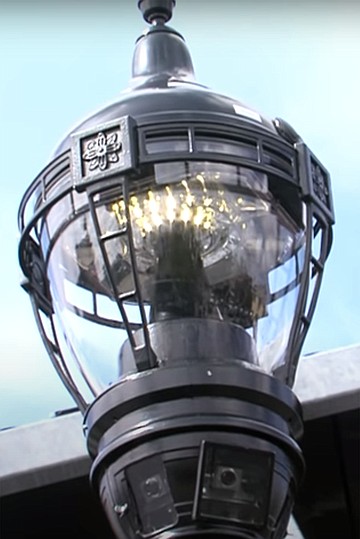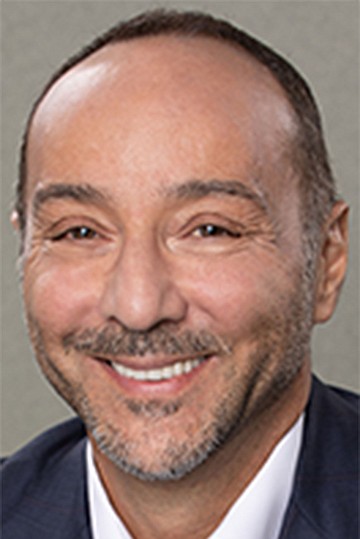 Facebook
Facebook
 X
X
 Instagram
Instagram
 TikTok
TikTok
 Youtube
Youtube
![“Smart Streetlights take photos/video on a 24/7 basis with stationary cameras. The technology records images in a stationary field of view. It is not maneuvered by a person, is not monitored, and is not used to surveille [sic] citizen activity.”](https://media.sandiegoreader.com/img/photos/2022/12/12/RADAR_Smart_Streetlight_traffic_optimization_t670.jpg?b3f6a5d7692ccc373d56e40cf708e3fa67d9af9d)
San Diego, a city that for years seemed unaware of the spy cams in its midst, is again being reminded of its ever-present network of surveillance devices. The first exposure came on February 20, 2019, in a Reader cover story about the installation — under the administration of Republican then-mayor Kevin Faulconer — of covert video and audio monitors on city streetlights. More than three years after that revelation, the city council finally passed a law requiring more public transparency.

“The surveillance oversight ordinance came about after it was made aware that the City of San Diego had smart streetlight cameras, thousands of them, installed all over the city without any education or information to the public,” Homayra Yusufi of a group called the Partnership for the Advancement of New Americans told public broadcaster KPBS after the new law’s passage in August of this year.
Now comes the San Francisco-based Electronic Frontier Foundation, presenting a photographic gallery of border spy devices operated by the U.S. government in a November 29 website post. According to EFF, “The U.S.-Mexico border is one of the most politicized technological spaces in the country, with leaders in both political parties supporting massive spending on border security and the so-called ‘Virtual Wall.’ Yet we see little debate over the negative impacts for human rights or the civil liberties of those who live in the borderlands.”
Per the post, “Our goal is not only to ensure there are alternative and open sources of visual information to inform discourse, but to raise awareness of how surveillance is impacting communities along the border and the hundreds of millions of dollars being sunk into oppressive surveillance technologies.” Big Brother technology has saturated the region, according to the findings. “This surveillance tech watches not just the border and people crossing it, but also nearby towns and communities, on both sides, from the air and the ground, and it can track them for miles, whether they’re hiking, driving to visit relatives, or just minding their own business in solitude.” Among surveillance mechanisms called out by the report are so-called Autonomous Surveillance Towers from a company “founded by Oculus-creator Palmer Luckey.” The device “scans the environment with radar to detect movement, orients a camera to the location of the movement detected by the radar, and analyzes the imagery using algorithms to autonomously identify items of interest.”
Not everyone is convinced that such surveillance, including the now mostly defunct set of controversial San Diego streetlight spy cams, is deleterious. “The Smart Streetlight technology is non-discriminatory,” argued the San Diego County Grand Jury in a June 23, 2022, report, citing a rise in crime requiring better police responses. “Smart Streetlights take photos/video on a 24/7 basis with stationary cameras. The technology records images in a stationary field of view. It is not maneuvered by a person, is not monitored, and is not used to surveille [sic] citizen activity.”
While those conclusions remain in dispute, the Grand Jury’s summation of the surveillance program’s costs is more widely accepted. “Smart Streetlights were purchased with a $30.23 million dollar loan from [General Electric]. The City of San Diego continues to pay $2.3 million dollars per year on this loan,” the findings say. “The savings from reduced energy use was to cover this loan payment, but the savings never materialized because not all Smart Streetlights were ever installed. This loan was executed on December 13, 2016. It dedicated $11 million dollars to Smart Streetlights sensors. Ongoing costs continue, and additional capital will be needed to upgrade the devices as they have not been used for over 18 months.” Adds the report, “In the February 12, 2020, memorandum from City management, it is noted that only estimates for the additional costs can be stated since no Requests for Proposals for these contracts can be issued to restart services.”
There’s a lot of money to be made from teeth, based on the record of a mega-millionaire dentist whose associated limited liability company just bought actress Sandra Bullock’s 91-acre Valley Center avocado farm for $5.6 million. The transaction was first reported by the Union-Tribune on December 7. State records show that Amir Neshat, President & Chief Executive Officer of Liberty Dental Plan. Inc. is behind buyer IAAA LLC. In January 2002, according to a Liberty news release, Neshat “purchased a small dental insurance company based in California with a few hundred members, with the goal of improving health outcomes for its members and local communities.

As of 2021, Liberty administered to approximately 5.7 million members in all 50 states, with the expectation to surpass well over 6 million members in 2022. ‘We grew organically,’ reflected Dr. Neshat.” According to the U-T’s account of the Bullock deal, “the massive property includes a 5938-square-foot Mediterranean-style house with four bedrooms and six bathrooms, avocado and citrus tree groves, a chicken coop, a gated driveway, a saltwater pool, and plenty of security cameras.” The movie star paid just $2.7 million for the estate in 2007, and listed it this past summer for $6 million, the paper says.
His profile on LinkedIn says Neshat got his bachelor’s degree from UCSD in 1989 and a dental degree from the University of Southern California in 1994. The brother of noted photographer and director Shirin Neshat, he was an executive producer of her 2022 film Land of Dreams, starring Matt Dillon. A critic of the current Iranian regime, Shirin's art is incorporated into a project on Roosevelt Island off Manhattan dedicated to “the courageous Iranians who are risking their lives to express their human rights,” according to Smithsonian.com.
— Matt Potter
The Reader offers $25 for news tips published in this column. Call our voice mail at 619-235-3000, ext. 440, or sandiegoreader.com/staff/matt-potter/contact/.

![“Smart Streetlights take photos/video on a 24/7 basis with stationary cameras. The technology records images in a stationary field of view. It is not maneuvered by a person, is not monitored, and is not used to surveille [sic] citizen activity.”](https://media.sandiegoreader.com/img/photos/2022/12/12/RADAR_Smart_Streetlight_traffic_optimization_t670.jpg?b3f6a5d7692ccc373d56e40cf708e3fa67d9af9d)
San Diego, a city that for years seemed unaware of the spy cams in its midst, is again being reminded of its ever-present network of surveillance devices. The first exposure came on February 20, 2019, in a Reader cover story about the installation — under the administration of Republican then-mayor Kevin Faulconer — of covert video and audio monitors on city streetlights. More than three years after that revelation, the city council finally passed a law requiring more public transparency.

“The surveillance oversight ordinance came about after it was made aware that the City of San Diego had smart streetlight cameras, thousands of them, installed all over the city without any education or information to the public,” Homayra Yusufi of a group called the Partnership for the Advancement of New Americans told public broadcaster KPBS after the new law’s passage in August of this year.
Now comes the San Francisco-based Electronic Frontier Foundation, presenting a photographic gallery of border spy devices operated by the U.S. government in a November 29 website post. According to EFF, “The U.S.-Mexico border is one of the most politicized technological spaces in the country, with leaders in both political parties supporting massive spending on border security and the so-called ‘Virtual Wall.’ Yet we see little debate over the negative impacts for human rights or the civil liberties of those who live in the borderlands.”
Per the post, “Our goal is not only to ensure there are alternative and open sources of visual information to inform discourse, but to raise awareness of how surveillance is impacting communities along the border and the hundreds of millions of dollars being sunk into oppressive surveillance technologies.” Big Brother technology has saturated the region, according to the findings. “This surveillance tech watches not just the border and people crossing it, but also nearby towns and communities, on both sides, from the air and the ground, and it can track them for miles, whether they’re hiking, driving to visit relatives, or just minding their own business in solitude.” Among surveillance mechanisms called out by the report are so-called Autonomous Surveillance Towers from a company “founded by Oculus-creator Palmer Luckey.” The device “scans the environment with radar to detect movement, orients a camera to the location of the movement detected by the radar, and analyzes the imagery using algorithms to autonomously identify items of interest.”
Not everyone is convinced that such surveillance, including the now mostly defunct set of controversial San Diego streetlight spy cams, is deleterious. “The Smart Streetlight technology is non-discriminatory,” argued the San Diego County Grand Jury in a June 23, 2022, report, citing a rise in crime requiring better police responses. “Smart Streetlights take photos/video on a 24/7 basis with stationary cameras. The technology records images in a stationary field of view. It is not maneuvered by a person, is not monitored, and is not used to surveille [sic] citizen activity.”
While those conclusions remain in dispute, the Grand Jury’s summation of the surveillance program’s costs is more widely accepted. “Smart Streetlights were purchased with a $30.23 million dollar loan from [General Electric]. The City of San Diego continues to pay $2.3 million dollars per year on this loan,” the findings say. “The savings from reduced energy use was to cover this loan payment, but the savings never materialized because not all Smart Streetlights were ever installed. This loan was executed on December 13, 2016. It dedicated $11 million dollars to Smart Streetlights sensors. Ongoing costs continue, and additional capital will be needed to upgrade the devices as they have not been used for over 18 months.” Adds the report, “In the February 12, 2020, memorandum from City management, it is noted that only estimates for the additional costs can be stated since no Requests for Proposals for these contracts can be issued to restart services.”
There’s a lot of money to be made from teeth, based on the record of a mega-millionaire dentist whose associated limited liability company just bought actress Sandra Bullock’s 91-acre Valley Center avocado farm for $5.6 million. The transaction was first reported by the Union-Tribune on December 7. State records show that Amir Neshat, President & Chief Executive Officer of Liberty Dental Plan. Inc. is behind buyer IAAA LLC. In January 2002, according to a Liberty news release, Neshat “purchased a small dental insurance company based in California with a few hundred members, with the goal of improving health outcomes for its members and local communities.

As of 2021, Liberty administered to approximately 5.7 million members in all 50 states, with the expectation to surpass well over 6 million members in 2022. ‘We grew organically,’ reflected Dr. Neshat.” According to the U-T’s account of the Bullock deal, “the massive property includes a 5938-square-foot Mediterranean-style house with four bedrooms and six bathrooms, avocado and citrus tree groves, a chicken coop, a gated driveway, a saltwater pool, and plenty of security cameras.” The movie star paid just $2.7 million for the estate in 2007, and listed it this past summer for $6 million, the paper says.
His profile on LinkedIn says Neshat got his bachelor’s degree from UCSD in 1989 and a dental degree from the University of Southern California in 1994. The brother of noted photographer and director Shirin Neshat, he was an executive producer of her 2022 film Land of Dreams, starring Matt Dillon. A critic of the current Iranian regime, Shirin's art is incorporated into a project on Roosevelt Island off Manhattan dedicated to “the courageous Iranians who are risking their lives to express their human rights,” according to Smithsonian.com.
— Matt Potter
The Reader offers $25 for news tips published in this column. Call our voice mail at 619-235-3000, ext. 440, or sandiegoreader.com/staff/matt-potter/contact/.
Comments